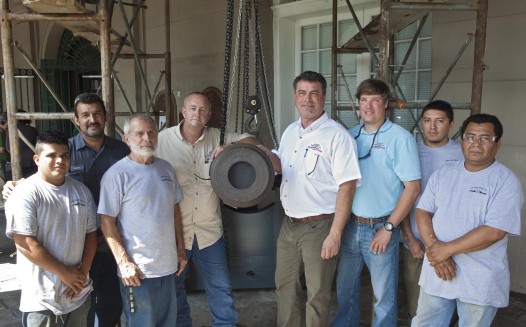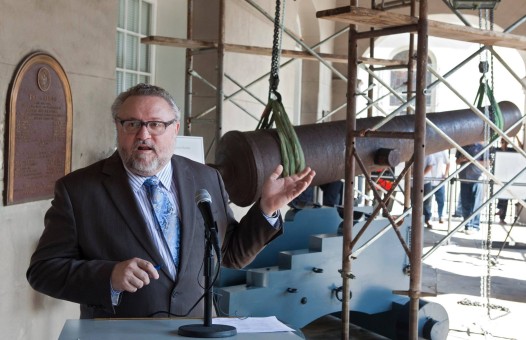
Members of Abry Brothers, founded in 1840, include Joel Argueta, Foreman Melvin Erazo, Project Manager John Abry, Operations Manager Scott Wolf, President Greg Abry, Anthony Marciante, Freddie Alvarado, and Edwin Perez. The crew built two 20,000-pound-capacity shoring towers, spanned them with two 250-pound cross beams, and gently lowered the massive Spanish cannon onto the carriage’s bed via two three-ton chain hoists. Photo: Mark J. Sindler/Louisiana State Museum
What do you do with a two-century-old canon in this age of drones and missiles?
You put it on display somewhere.
In New Orleans, one of these vestiges of long-ago wars, the one on at the entrance to the Cabildo in Jackson Square, wasn’t always on display. This one was actually dumped in Bayou St. John when the city was captured during the Civil War. There it stayed until is was raised in 1872 and returned to its original location at Fort St. John. There it was an object of display until 1908, when it was transferred to the Louisiana State Museum.

At the arcade of the Cabildo, Mark Tullos, Jr., Director of the Louisiana State Museum system, shows off the reconstructed naval carriage that now cradles the LSM’s Spanish cannon. The storied gun was used by American defenders at the Battle of New Orleans in Chalmette in 1815 and also against Admiral David Farragut’s Union fleet in 1862. Photo: Mark J. Sindler/Louisiana State Museum
Now this almost-6,000-pound behemoth has been readied for the LSM’s upcoming bicentennial celebration of the Battle of New Orleans beginning in January, 2015. It has received a new carriage of Spanish cedar, built by the master carpenters on the LSM’s maintenance crew, a replica of the original. To honor their craftsmanship, Mark Tullos, Assistant Secretary of Culture, Recreation and Tourism, who is also the LSM Director, took the unusual step of having a plaque made in their honor — a generous tip of the hat from a director to a museum maintenance crew.
“This is a big moment for the museum staff,” Tullos said. “This whole project engendered a lot of pride for everyone here.”
Moving something almost three tons in weight was a choreographed work of pulleys and chains, human labor and patience. But the staff effort of moving the cannon onto its new carriage inch by inch was greeted by cheers and applause from an invited audience of LSM supporters and the media.
The removal process was made possible with underwriting from local law firm Baldwin Haspel Burke and Mayer and is the first in a year-long series of activities associated with the exhibition Dirty Shirts to Buccaneers: The Battle of New Orleans in American Culture, opening January 11, 2015.
Stay tuned.
 NOLAbeings Multimedia artist Claire Bangser created NOLAbeings as a portrait-based story project that marries...
NOLAbeings Multimedia artist Claire Bangser created NOLAbeings as a portrait-based story project that marries...  Voodoo in New Orleans: Reviving history: New Orleans fortune telling This article takes a deep dive into the history of Voodoo in New Orleans, its hybridization with Catholicism, and its present-day place in the city's culture. The author visits fortune-tellers in the French Quarter, using their guidance as a tool for introspection rather than a deterministic predictor of the future. Through her experiences in New Orleans, the author feels a mystical connection to both the past and the future.
Voodoo in New Orleans: Reviving history: New Orleans fortune telling This article takes a deep dive into the history of Voodoo in New Orleans, its hybridization with Catholicism, and its present-day place in the city's culture. The author visits fortune-tellers in the French Quarter, using their guidance as a tool for introspection rather than a deterministic predictor of the future. Through her experiences in New Orleans, the author feels a mystical connection to both the past and the future. 